REBECCA RENNIE BIG BOARD: SMALL SCHOOL TOP 50 (PAGE 2)
By Rebecca Rennie
As with every draft class, there is exceptional talent to be found outside the FBS. This presents my Top 50 of those small school prospects. This is year two of producing this form of content. Though less extensive than the Top 150 presented last year, I believe the process and resulting content is much better this time around. Surprisingly, the near 22,000 word count actually exceeds that of last year’s big board write up.
The first four pages provide profiles on the Top 40 small school prospects. Page 5 contains the full Top 50 Big Board as a list. There is a lot of high quality prospects in the 2021 class from the FCS and beyond. Those appearing near the bottom on the list are fully capable of enjoying a pro career with the right opportunity. There are a number of players also absent from this list. I’ve attempted to watch as many as possible but know that a few will have been missed.
There is a lot of content within this project, and would be surprised if many intend to read this start to finish. However, whether used pre-draft or after your team has picked up one or more of these players during or after the draft, I hope this provides some useful information or reference.
11. Bryan Mills, CB, North Carolina Central. Grade: 5th Round
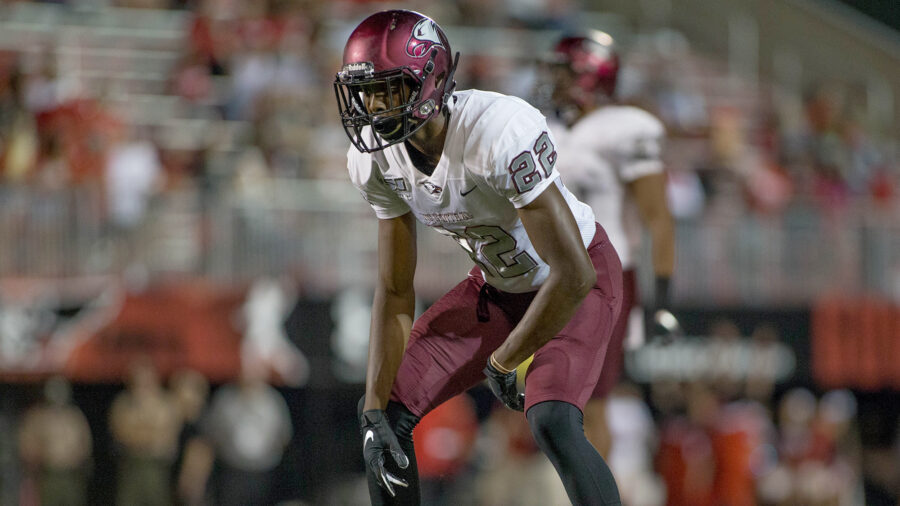
Height: 6’1”. Weight: 174 lbs.
Pros: Mills had his ups and downs at the Senior Bowl, somewhat expected in facing higher caliber opposition. There were more than enough promising flashes though, reflecting his status as a worthy developmental prospect. The 2019 film is strong, showcasing a well-rounded skill set in pass coverage, good fundamental technique, smart play and reads. His physical tools include utilizing his length, efficient footwork and solid long speed.
The Eagles corner impresses in coverage. Looking the part from press, Mills applies his length and extension in the initial stages of routes. There is enough fluidity to effectively transition into his run, then able to open his stride to accelerate and maintain contact downfield. He may not have elite suddenness in his changes of direction, in part due to his long-limbed frame. However, he consistently shows sharp footwork with minimal wasted motion. His quick reads and reactions also assist in staying tight at the top of routes.
There is room to sharpen his game, but Mills shows positive awareness and positional IQ. He is rarely fooled by feints and shifts as receivers sell routes. He seldom gets panicked or uncomfortable, exhibiting reliable positioning and control. Mills knows his assignments and keys, while balancing his vision between quarterback and receiver. He looks equally comfortable executing in shorter field situations as he is with space behind between the 20’s. With good hand use throughout, he doesn’t often grab downfield to draw many flags.
Finally, Mills is effective at the catch point. In particular, he high points very well, not only through his length but with a good vertical (37”) and excellent timing. He ought to handle matchups with taller receivers, more so as he continues developing his currently lean frame. He finishes well with excellent ball skills to secure interceptions. He concluded his 2019 season with 8 breakups and 5 interceptions. He has his flaws in the run game but puts in enough effort and commitment as a tackler.
Cons: It goes without saying that small school prospects generally face a relatively steep step up in competition level. While even experienced players at his level take on that tricky transition, Mills has the added difficulty of only one season’s experience at the FCS level as a JUCO transfer from College of Canyons. He had an excellent year in that singular 2019 season but that could factor into more conservative projections for some.
The lighter listed weight for his frame will lead to some expectations of requiring time before seeing significant action. His film is in no way timid in nature though, battling well in press man and contested situations. While effort in run support is encouraging, there are some negatives in assisting the ground game. Poor angles and difficulty working through traffic show up frequently. Some substandard technique and application can lead to occasional misses when in position. Mills had some mixed testing results, including a concerning 4.60 dash time.
Wrapping Up: The JUCO transfer is a developmental prospect but has demonstrated more beyond basic physical tools and traits. He is arguably not as raw as expected, aided by efficient footwork, good recognition and decision making. Nor is he as physically overmatched as occasionally inferred, though still could use additional strength and conditioning for the NFL level relative to FCS competition faced. The combination of length, ball skills, footwork and instincts give Mills growth potential. Progressing to a starting CB2 is not beyond his possible ceiling with time and patience. The slower 40-yard dash could knock him down boards for some teams.
12. Mike Strachan, WR, Charleston. Grade: 6th Round
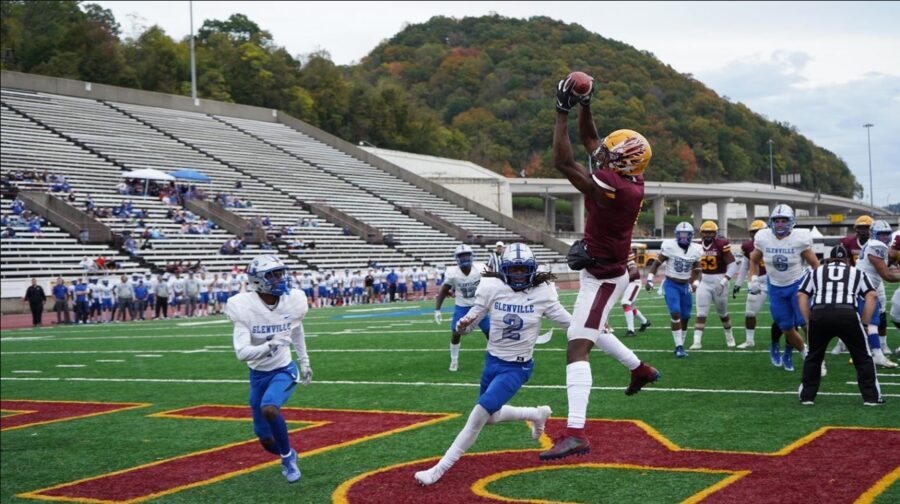
Height: 6’5”. Weight: 226 lbs.
Pros: Not many from Division 2 find a path to the NFL but Strachan has the physical frame that is assured to draw interest. The general caveat typically applied to players at that level to immediately stand out above others and to dominate the competition are conditions comfortably met. The physical mismatches were routinely evident on film as Strachan compiled tangible production. His 2019 season included 78 receptions for 1,319 yards (16.91 average) and an eye-opening 19 touchdowns.
Self-aware, Strachan has acknowledged being highly raw early in his college career. He has worked on improving his route running in particular, though it is still a work-in-progress. His changes of direction and breaks are impressive for his build. He has seen some varied usage at Charleston, lining up on both sides of the line of scrimmage, working deep downfield and on shorter targets crossing over the middle of the field. His impact as a big-play threat included averaging almost 21 yards a catch in 2018. A track athlete, Strachan’s long speed is proven as the school record holder at 400m. He wowed at his pro day with 4.46 speed at his size.
A large proportion of Strachan’s wins heavily involve maximizing his physical advantages. He understands how to utilize his strength on contact from press coverage and control his route path. The Golden Eagles receiver may not consistently shake coverage but takes ownership of the catch point. Strachan uses his size and power as he positions himself relative to the DB. His expansive catch radius and ability to high point over most corners is a matchup that he will generally win. He frequently draws defensive pass interference calls and eagerly applies himself as a blocker for teammates.
Cons: Though he has worked on improving technically, Strachan has a long way to go in many aspects of his receiving skills. His release, footwork and hand use do not consistently compliment his physical abilities when working off coverage. Route running remains rough, including lost momentum in his breaks at the top of routes and some unsubtle sells.
There is clear top-end speed to pull away from D2 defenders once opening his stride in straight-line situations. That said, despite the track background, he can require a bit of a wind-up to reach his peak speed. Strachan is absolutely able to win out at the catch point but separating consistently isn’t there as yet. As he develops though, it’s easy to envision being difficult to stop should his overall game improve.
Wrapping Up: Strachan clearly has well-defined and desirable physical traits centered around his size, length and strength. A developmental project, he has so much potential if his technique can be sharpened up. His position across draft boards likely will vary dependant on the level of optimistic outlook. Regardless, he seems likely to hear his name on Day 3.
13. Drew Himmelman, OT, Illinois State. Grade: 6th Round
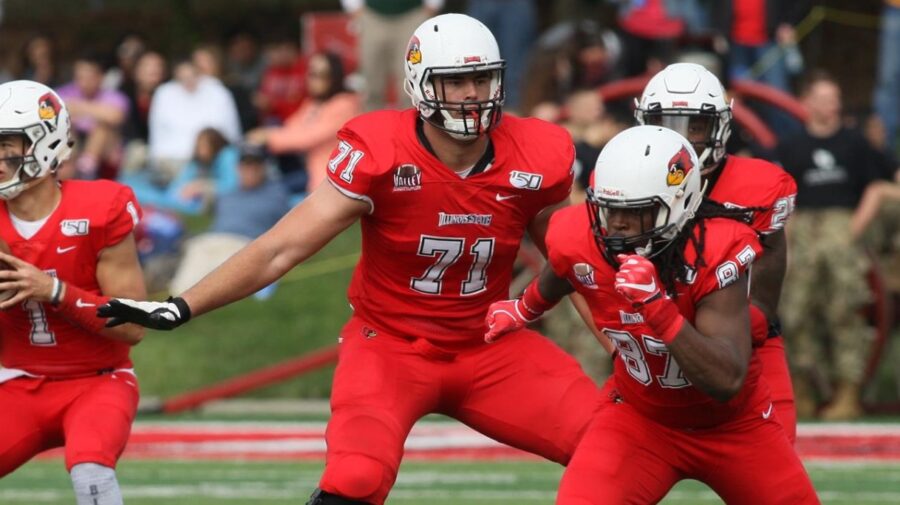
Height: 6’9”. Weight: 315 lbs.
Pros: Himmelman has been a known name on the NFL Draft radar for some time. Though debatable whether it is truly an advantage, his 6’9” height and 315 lb listed frame inevitably draws interest. Himmelman was a 230 lb TE and DL out of high school. Though he could have walked on at Iowa, he was a zero-star prospect with Illinois State as his only offer.
Aside from a two-game foot injury absence, Himmelman has been a three-year starter at left tackle up to 2019, and has continued to play during the 2021 spring season. He has succeeded in adding considerable bulk but is still relatively lean with room to potentially add more.
The Redbirds O-lineman makes use of his length fairly well on first contact and to aid him late against speed outside to force rushers wider. Against most opposition on film his pad level doesn’t hinder him too greatly. Winning reps often involve getting good early extension and limiting access to his own chest. Though not a notable athlete, he has enough foot quickness to effectively work upfield in a straight line.
There are a lot of positives in his mental game and football IQ. He has consistent timely release from his stance and looks coordinated in his pass pro sets. Though far from the most agile mover, Himmelman anticipates well, aiding him against counters. Overall, he plays calm and composed. He is more prone to attacking into contact than playing passive. He plays combatively when driving as a run blocker.
Cons: As hinted earlier, it can certainly be argued that Himmelman’s height is as much a hinderance as a help. He is generally at a disadvantage in terms of leverage and pad level. When defenders exploit that, he can be knocked off balance, have his anchor raised and worked back into the pocket. In those instances, it can appear difficult for him to reset his feet and recover.
Himmelman does not appear to be a standout athlete. The lack of ideal agility and flexibility is noticeable in his lateral and backward movements. He makes it work during most pass pro reps but often has to abandon his kick slide early into more of a run in attempting to stay in phase with speed rushes. Not helping his stock, Himmelman is an older prospect, set to be a 25-year-old rookie.
Wrapping Up: A Combine invite, Himmelman has continued to play this spring season. He catches the eye early when watching Illinois State football with his rare size. In fairness, he is steady and controlled on film. The frame he offers should earn a draft selection on Day 3. There are concerns though, relating particularly to his pad level and athleticism. Those questions, along with his age, may limit how early he hears his name called.
14. Kenny Randall, DL, Charleston. Grade: 6th Round
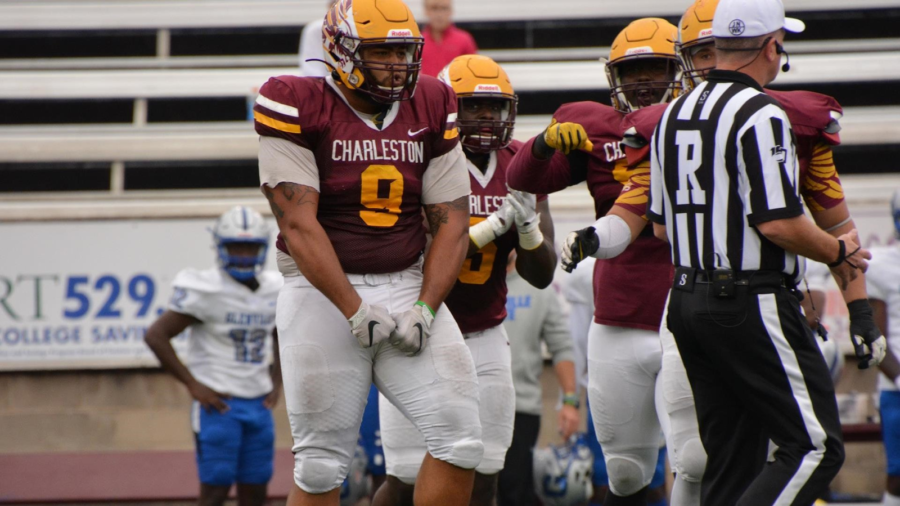
Height: 6’2”. Weight: 314 lbs.
Pros: A Division 2 prospect, Randall had Division 1 ability. Initially recruited to Temple by Matt Rhule, he ultimately fell short of academic requirements to join the Owls. Charleston ended up as his best opportunity. He stood out overtly at that level however, and has NFL interest in this pre-draft process.
Double-digit teams reportedly requested his attendance at West Virginia’s pro day. He measured in positively and tested well. His 32 3/4″ arm length and 10 1/4 hands were goo marks to hit. He added a 5.04 dash (1.65 split), 34” vertical, 9-9 broad and 29 bench reps amongst his numbers. Primarily lining up at nose tackle, Randall piled up 64 tackles, 16.5 TFLs, and 7 sacks in 2019. He added 2 forced fumbles and 2 blocked kicks on special teams.
The Golden Eagles defensive lineman dominated as a clear physical presence above those around him at the Division 2 level. Randall consistently overpowered opposing O-linemen, demanding additional attention from multiple blockers. While not overly dynamic, he is far from sluggish despite the dense, powerful build. He brings a fervency and energy as part of a high motor and violent play style.
The power at the point of attack is plainly evident. He backs it up with power and extension behind his punch. Randall fires low with his hands, with accurate placement and effectively raises anchors. He generally relies on a simple bull rush rather than an assortment of rush moves and counters but few could handle his physicality. Randall consistently holds his ground and is frequently able to buckle pocket integrity. Bullying his way into the backfield, he finishes with forceful takedowns.
Cons: While the case for many, 2020 was certainly a season of missed opportunity for Randall. With pre-season compliments from Jim Nagy, he was on the radar for the Senior Bowl, but ultimately not invited. He did receive an invite to the next tier All-Star event, the East-West Shrine game. The event never went ahead though, removing a chance to impress against better competition. Despite the pro day interest, Randall did not land on the Combine invite list. All in addition to being unable to compete in 2020, with plans to show better pass rush variety on film.
Speaking of which, Randall is built to hold up well at the NFL level, but likely projects to a lower impact role. Interior pass rush ability garners higher value over the more understated but effective contributions Randall ought to provide. His bullrush is disruptive but there is a lack of sophistication to his upper body technique. While he had plans to show more counters off contact and rush moves, it’s rarely present from 2019 film.
Wrapping Up: Charleston are producing good players with former DL teammate John Cominsky drafted recently to the Falcons and fellow 2021 prospect Mike Strachan a draftable wide receiver also. Heavy-handed with impressive power at the point of attack, Randall has requisite size and strength for the pro level. While his ceiling and impact may be limited, he is capable of effective gap control against the run, holding his ground and working back the OL to close the pocket. While not invited to the Combine, he feels worthy of a late draft selection, regardless.
15. Franklin "Mac" McCain III, CB, North Carolina A&T. Grade: 7th Round
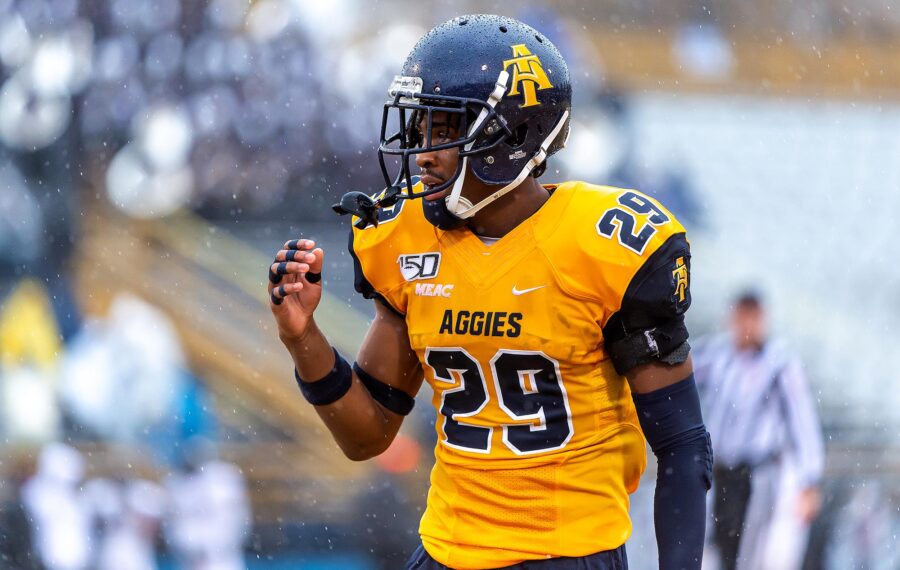
Height: 5’11”. Weight: 186 lbs.
Pros: After no selections since 2005, The Aggies had a 3-year run of drafted players from 2017 to 2019. After being shutout last draft, they again have a couple candidates who could hear their name in 2021. Mac McCain has been one of the standout corners in the FCS since an explosive introduction his freshman season. That included six interceptions as a college rookie, taking half back for touchdowns. Though disappointingly left without a Combine invite, he was on the East-West Shrine Game roster. The event did not go ahead but reflects his presence on the NFL’s radar.
Though his frame is relatively small, McCain measured in slightly bigger than expected at his pro day. He has shown good athletic traits, most notably during an exceptional 2018 sophomore season. Loose hipped, he shows fluidity to transition, smoothly opening up to turn and run from press. A quick-twitch athlete, McCain has suddenness over short distances and longer speed to run deep. Able to cover ground in his backpedal, he shows fast but controlled footwork. The pre-draft testing numbers reflected the movement shown on film.
McCain has consistently demonstrated playmaking ability and an opportunistic high-IQ game. He impresses with his ability to stay in phase with receivers in man coverage. Anticipating and mirroring movements, he proves difficult to shake, minimizing separation in part due to his good footwork and agility. A quick decision maker, he trusts his reads and plays aggressive, factoring into his ball production. While slightly built, McCain is tenacious and committed in contested situations and in run support.
Cons: Much of the positive notes above relating to his athletic tools are most prominently present from 2018 film. McCain missed the final few games of 2018 with a torn ACL. Not yet recovered to begin 2019, he also missed the first several games of 2019 also. At times during his 2019 film, McCain didn’t look quite so sharp in his movements and may still have been working his way back to full fitness and comfort. The pro day was encouraging though, testing as the well-rounded athlete he previously indicated to be.
While he has the short-area quickness to click-and-close effectively, McCain frequently proved beatable on comebacks and curl routes, at times leaving too much cushion underneath from off coverage and bail. While the previously mentioned aggressiveness can result in big plays, McCain is prone to biting on double moves and fakes. Though playing up to physical challenges, the A&T defensive back can be occasionally overmatched at the catch point.
Wrapping Up: McCain is an impressively instinctual corner with plus technique and footwork. His sharp movements and speed generally makeup for a relative lack of ideal size, bulk and play strength. Frequently following leading receivers around the field, he is comfortable playing outside on both sides and from the slot, projecting well to the latter. There is some inconsistent film, but the confidence and playmaking are evident and encouraging. Good medical feedback could see him selected on Day 3 of the draft, particularly following the positive pro day.
16. KJ Stepherson, WR, Jacksonville State. Grade: 7th Round
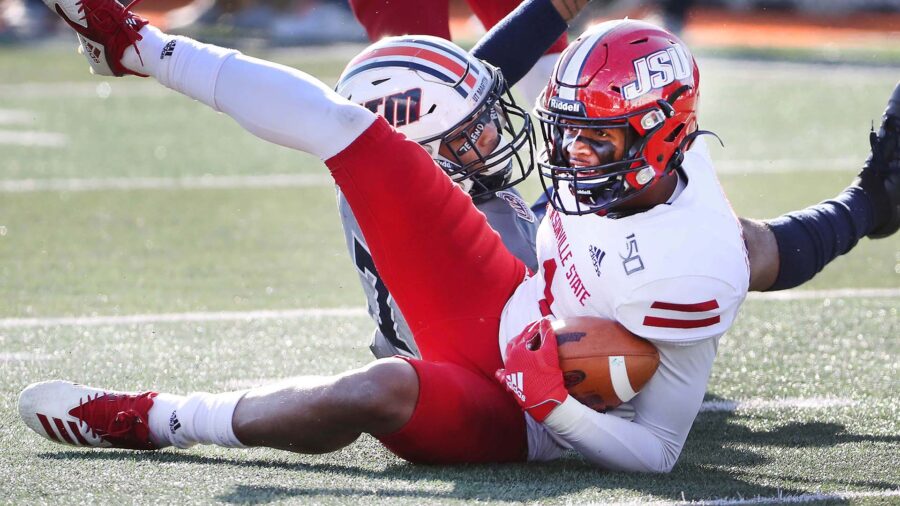
Height: 6’0”. Weight: 188 lbs.
Pros: Unlike many small school prospects, Stepherson can cite some outstanding game film against quality competition. Adding to the intrigue, the production and highlights burning talented DBs came as just a true freshman. Stepherson began his college career at Notre Dame as a 3-star recruit out of high school. That 2016 season totalled 25 receptions for 462 yards (18.5 average) and 5 TDs. The dynamic big-play threat added 359 yards in 2017 on just 19 catches, an 18.9 average and 5 touchdowns.
Off-field incidents led to Stepherson re-emerging with Jacksonville State in 2019. Fortunately, he seems to have kept a lower profile over the past few years. He compiled 479 yards on 36 receptions and 6 touchdowns in his lone season with the Gamecocks. A twitched-up athlete, the burst and explosiveness is visible on film. Taking part at Auburn’s pro day, his testing included a 38.5” vertical, 10-7 broad, and 6.99 3-cone. Though officially running a 4.66 dash, he’s reportedly tested in the 4.4s previously. The dash testing is a concern but the play speed on game film looks legit.
The production numbers in 2019 were modest for the FCS level. However, the film showcased the translatable receiver skills frequently. It is easy to see why he made such an early impact at Notre Dame, with instinctive abilities. Stepherson regularly executes on intuitive shifts that come very naturally, setting up DBs with step frequency variance and timing. He innately drifts smoothly and subtly into open space between coverage.
Stepherson has traits to be a factor on multiple levels. He is dangerous from a free release, quickly accelerating off the line. He also displays separation quickness and suddenness at the top of his routes. There is exciting ability on deep targets. Stepherson tracks the ball smoothly, times his hands and routinely snags the ball out of the air confidently and cleanly. He secures the ball on off-target throws and high points impressively on jump balls. The Fighting Irish transfer can be equally effective on shorter in- and out-breaking routes and with run-after-catch opportunities. He is savvy getting open on broken plays and QB scrambles.
Cons: The character history is extensive. Stepherson was part of a group of six Notre Dame players arrested across two incidents in 2016. The arrest related to marijuana and handgun possession charges. After the 2017 regular season concluded, he was arrested for marijuana possession and driving without a licence. The very next day, he was arrested again for shoplifting and dismissed from the team. Less than a month later, Stepherson was again arrested for drug possession.
It appears he has avoided further incidents over the past couple years. Hopefully there has been some maturity, as the on-field product has been great. The previously referenced dash time at his pro day was surprisingly slower than the film suggests. With a slighter build, Stepherson’s game lacks power. He is able to win at the catch point vertically but lacks an overall physical presence. The 7 bench reps at the pro day are reflective of that limitation. He gives solid effort as a blocker, however, when asked.
As good as his separation quickness and change of direction is, Stepherson’s footwork could be tighter and more consistent. He has his moments of requiring a couple extra steps to make his cuts or comebacks. A little refinement in his route running overall will maximize his natural traits to work corners and create throwing windows.
Wrapping Up: The potential variance of impact with Stepherson is wide-ranging. A pro career may not work out for him, or he could end up as a significant steal. The eye-opening flashes at Notre Dame were some time ago. Yet, despite unspectacular numbers at Jacksonville State, the talent and traits remain present. Stepherson is highly instinctive and versatile with projectable movement traits and ball skills. He could be argued as an ideal candidate to take as a late-round flyer with upside at a low investment cost.
17. Keyion Dixon, WR, Eastern Kentucky. Grade: 7th Round
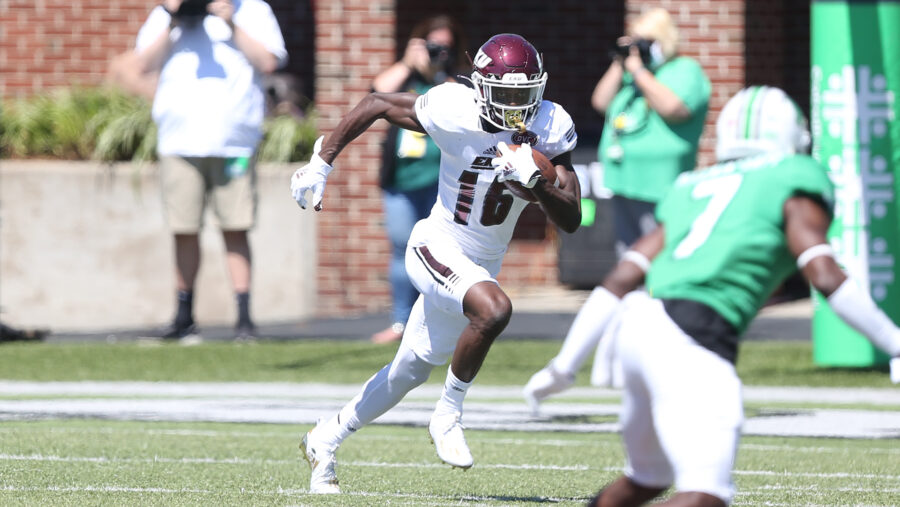
Height: 6’2”. Weight: 190 lbs.
Pros: Dixon has been a popular figure on the NFL Draft All-Star circuit, including participating in the Tropical and Hula Bowls. A UConn transfer, Dixon is a well-rounded athlete who impressed as a hurdler on the track in high school. At that level he featured at quarterback, wide receiver and defensive back, and ran for over 1,500 yards as a high school senior. His college freshman season showed promise at Connecticut but transferred to Eastern Kentucky after a reduced role as a sophomore. Despite some passing game limitations in the Colonels offense, he was able to showcase his abilities at the FCS level.
Dixon is an appealing blend of frame and athletic traits. He offers a lean but toned physique and good length at 6’2” with over 32” arms. A smooth, flexible and fluid mover, Dixon impresses with his releases and quick acceleration. In addition to the initial upfield burst, there’s good top speed, eating up yardage once opening his stride. Faced with press, off, man and zone coverages, he generally copes with each sufficiently.
What frequently stood out from Dixon’s film was his releases and polished hand use off the line. He consistently finds ways to win, effectively deflecting contact and taking the early initiative. The Colonels receiver uses extension, swim and swipe moves as part of his attempts to establish separation quickly. Often an area under-developed among college prospects, Dixon appears more nuanced than many in this facet of his execution. This gives some encouragement for his game to translate, alongside his overall IQ and situational awareness.
The base-level athleticism allows for impact on multiple levels of the field. He is frequently featured on short targets, over the middle, and downfield. Dixon has shown he can work well as a runner after the catch, including a good feel for space and zones. He demonstrates sharp footwork, changing direction with minimal wasted motion at the top of routes. Though he’s shown inconsistencies with hands, he is capable of some impressive catches outside of his frame and offers a good target window.
Cons: As hinted above, the primary negative with Dixon is a frustrating lack of consistency at the catch point. For every solidly secured reception, there is often a missed opportunity to match. There are a few too many instances of being off with his ball tracking and hand timing. When unable to separate and faced with contested situations, he can be distracted on occasion by tight coverage.
The former 2-star recruit will likely be asked about his drop off in production while competing at the FBS level. UConn has not been the most conducive environment to playing tier one football in recent years. He may well have satisfied those questions when speaking to scouts and personnel in his interviews, however. A class of 2015 recruit and redshirt senior, Dixon is a slightly older prospect.
Wrapping Up: It’s easy to be underwhelmed by Dixon’s modest production numbers (115 catches in four seasons). The traits on film suggest a skill set better than the stats that can work in a rotational role at the pro level. QB play at Eastern Kentucky factored into some opportunity limitations with the Colonels. Dixon has intriguing length and athleticism alongside some technical refinement. Were he more consistently convincing at the catch point he could have garnered a higher grade.
18. Christian Elliss, LB, Idaho. Grade: 7th-HPFA
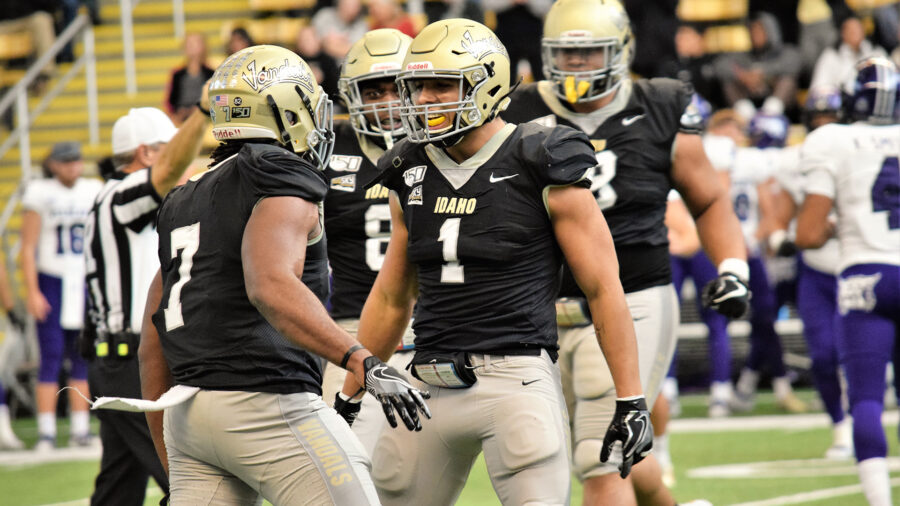
Height: 6’2”. Weight: 228 lbs.
Pros: One of the intriguing aspects of the 2021 draft class is a number of high-profile prospects from NFL pro bloodlines. Some small school sleeper prospects fall into that category also. Christian is the son of two-time pro bowler and former Detroit Lions defensive lineman Luther Ellis. His brother Kaden Elliss also played at Idaho, a 7th round selection of New Orleans and still on the Saints roster. Christian has the potential of his own pro career.
Elliss has starting experience at both inside and outside linebacker for the Vandals. Though a little undersized, he has good length for his frame with nearly 32” arms. He tested well overall at his pro day. Elliss had a 4.58 dash (1.63 split), 35.5” vertical, 10-1 broad, 6.94 3-cone and benched 22 reps. The productive and active defender hit triple digit tackles (104) in 2019, including 12.5 TFLs. Continuing to play in the 2021 spring season, he put up 51 tackles in just 5 games at the time of writing.
While not the biggest, Elliss shows good core strength. He is better than expected at working off contact and shedding blocks. In addition to the play strength, he uses his hands well to aid his path through traffic. The Vandals linebacker hits hard, bringing the momentum into each tackle attempt. He showcases good twitch, shift and change of direction when working downhill. Elliss is generally at his best working forward toward the action.
Elliss is a highly enjoyable watch overall, with the above abilities resulting in being consistently active around the football. There is obviously good football IQ and application of film study. He is a talented playmaker who is disciplined yet willing to take chances. With a playmaking mentality, he is a fast processor and quick decision maker. Those traits are only elevated through his high energy and hustling play style.
Cons: Elliss tested well with quickness and strength which hold up on film. That said, he can look a little limited in other areas. Working well forward, he appears less fluid working backward and laterally. His size may be typical of a space and coverage linebacker but may not have a high ceiling to offer defending the pass.
The sideline range is sufficient, aided by his quick reads and reactions alongside the motor. However, the size, athleticism and range combination relative to NFL standards maybe blends in with the pack a little more. The Idaho standout generally takes good angles to the football but when not, he can sometimes struggle to recover.
Wrapping Up: Elliss is heavily involved in multiple areas of the field and alignments within his defensive scheme. More than just a run-and-chase backer on the second level, he can rush the backfield and impress between the tackles. Working downhill well, he could threaten as a late blitzer also. Elliss’ basic height and weight measurables may seem small but he has length in his arms and good power within his frame. The sharp football IQ and instincts contribute to his active playmaking ways. He’s a potential late selection or high priority free agent pickup.
19. Landon Rice, TE, Jacksonville State. Grade: 7th-HPFA
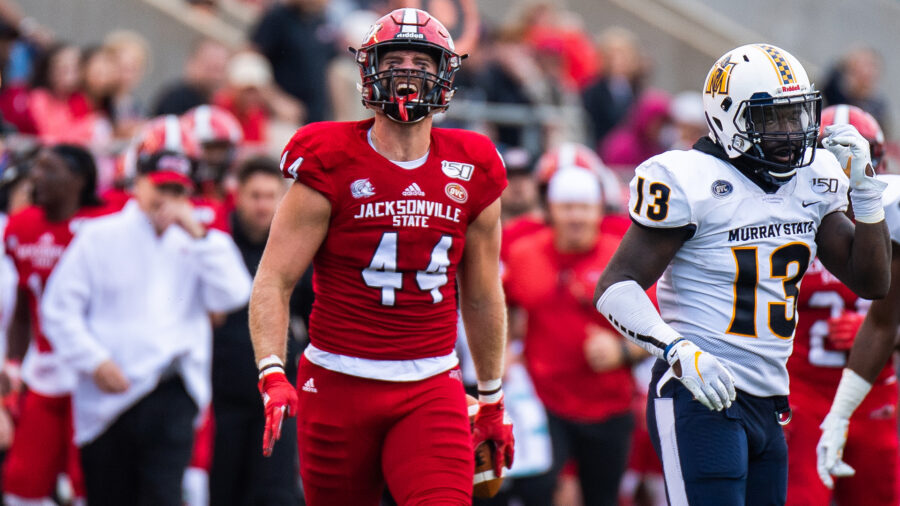
Height: 6’5”. Weight: 247 lbs.
Pros: The son of an offensive line coach, it’s no surprise that Rice excels as a blocking specialist. He has grown up learning proper OL techniques and drills, which shows in his execution. An area of playing the position that is frequently under-practiced, Rice clearly thrives and takes pride in his commitment in the trenches. He is not the broadest but has a good-sized frame, length and core strength. His pro day results at Georgia Tech’s event included 22 bench reps. That mark rivals the best results among tight ends at recent Combines.
The Gamecocks TE applies himself well to all blocking assignments. He can drive block off the line, lead block from H-back and mirror in pass protection. Rice impresses with his directional blocking, regularly turning his man and opening holes. He controls the action well and can dictate movement. When facing the rush, Rice sets up with the good form, footwork and coordination of an offensive tackle. He shows good understanding of requirements, with recognition and awareness relative to defensive alignments.
Though not overly productive, Rice is technically competent in the passing game. He runs accurate routes and shows reliable hands when targeted within his catch radius. He can utilize his strength well in contested situations. Rice can potentially chip in with a few check downs and has the physicality to generate some yardage after the catch. The receiving stats may not be great, but another pro prospect in Trae Barry saw more of the TE targets for JSU.
Cons: Beginning his college career at Auburn, the former 4-star recruit never played a snap for the Tigers. Enrolling in August 2016, by September 2016 he had left for personal reasons. Rice had been accused of rape, and some apologetic text messages went public. Ultimately, Rice was not indicted due to a lack of evidence. Regardless, he transferred to Mississippi State Community College, before joining Jacksonville State as a 3-star JUCO prospect in December 2017.
Rice tested well in the bench and a 9-9 broad jump, but otherwise was less impressive athletically. A 4.82 dash (1.69 split), 29.5” vertical, 4.56 shuttle and 7.33 3-cone were among his pro day results. His relative lack of quickness factors into struggles separating as a receiver. Rice totalled just four receptions in 2019 for 38 yards. He was a little more productive in 2018 with 18 catches for 224 yards and one touchdown.
As good as a blocker as Rice is, the limited agility and overall athleticism can be noticeable at times when facing speed off the edge and working in space. It is not prohibitive to his overall blocking, though he can look tight-hipped and will bend at the waist on occasions when reaching for his landmarks.
Wrapping Up: Rice may not provide an exciting ceiling yet has the potential to establish a lengthy career for himself. Blocking specialists at TE rarely become household names, yet those who exceed are valued within their organization. Rice is a limited athlete who may not provide much as a receiver. He does offer strength within a solid frame, alongside good technique and execution as a blocker. Rice has reportedly received some interest from the Seahawks, Colts and Broncos, among others. It would not be a surprise if he ends up a late round draft pick.
20. Chris Garrett, EDGE, Concordia-St. Paul. Grade: 7th-HPFA
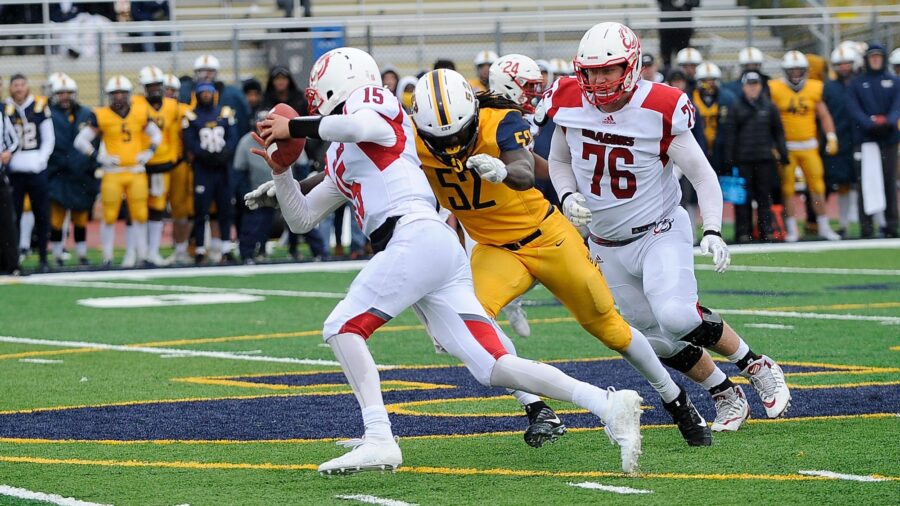
Height: 6’4”. Weight: 241 lbs.
Pros: A Division 2 prospect, Garrett certainly checks the box regarding dominating at the lower levels. The Harlon Hill nominee (D2 MVP) wreaked havoc and piled up numbers over three seasons. His 2019 season included 69 tackles, 20.5 TFLs, 14 sacks, 5 pass breakups and 7 forced fumbles. His abilities are clearly on the NFL radar. Garrett was invited to the cancelled East-West Shrine event, the NFLPA Bowl and the Hula Bowl, flashing well at the latter. Though ending up at Concordia-St. Paul, he was recruited by Wisconsin. Struggles with grades prevented earning the FBS scholarship.
Garrett didn’t have the best pro day but has reportedly tested better previously. His film includes good quickness and upfield burst. That backs up relentless energy and aggression throughout each rep. Garrett gets good extension and initial punch, working well at the point of attack. Though not the biggest, he has good length with over 32” arms. He proves difficult to shut down, even if controlled on the initial blocking exchange. Garrett is going to belligerently attack and counter, all while bending and angling with momentum toward the ball carrier.
Garrett demonstrates some go-to rush moves, including a strong-arm and to dip-and-rip with good flexibility to turn the corner. He can improve his body control and balance but shows nice bend and fluidity. He gets results, often aided by his hustle to finish each play. That effort to chase everything down and to the sidelines leads to additional tackles made against the run. A playmaker and opportunist, Garrett has a knack for creating game-changing moments, including forcing 15 fumbles over three seasons.
Cons: The hope was that Garrett would match some previously reported marks in athletic testing. Running in the 4.6 range and jumping at around 36” in the vertical were possible targets. Taking part in Minnesota’s pro day, he ultimately fell short of those results. The Golden Bears EDGE put together a 4.88 dash (1.65 split), 30” vertical, 9-0 broad, 4.31 shuttle, 7.15 3-cone and 11 bench reps. While not great, he showcases translatable short-area quickness and movement on film.
The high motor is mostly a positive, but Garrett needs to show more control as a rusher. He can get a bit over his pads and off-balance as he works through his rush attempts. There is an overall raggedness to his game currently with inconsistent control, form and execution. He has some effective moves but can add further variety to his rush repertoire. Garrett has some work to do as a run defender. He can get out of position, be late in his recognition and off on his angles. The excellent pursuit allows him to contribute but he can be a liability at times.
Wrapping Up: Playing primarily as a down lineman in college, Garrett’s physical profile projects to a varied role that ought to include rushing from a 3- and 2-point stance. A hard worker who overcame a difficult upbringing, the D2 prospect is driven to succeed. The phenomenal production was achieved legitimately with the potential to carry over. He can sharpen up his form and technique as a rusher but brings the high motor, upfield burst and flexibility to offer some developmental intrigue.
Feature Image Credit: North Carolina Central University Athletics

rebecca rennie
CFB/NFL DRAFT analyst
Rebecca is an NFL Draft analyst focusing primarily on the FCS and Group of Five conferences, and a fan of both the Tampa Bay Buccaneers and Stanford Cardinal. You can find her other articles here and follow on Twitter @bex_r86.
